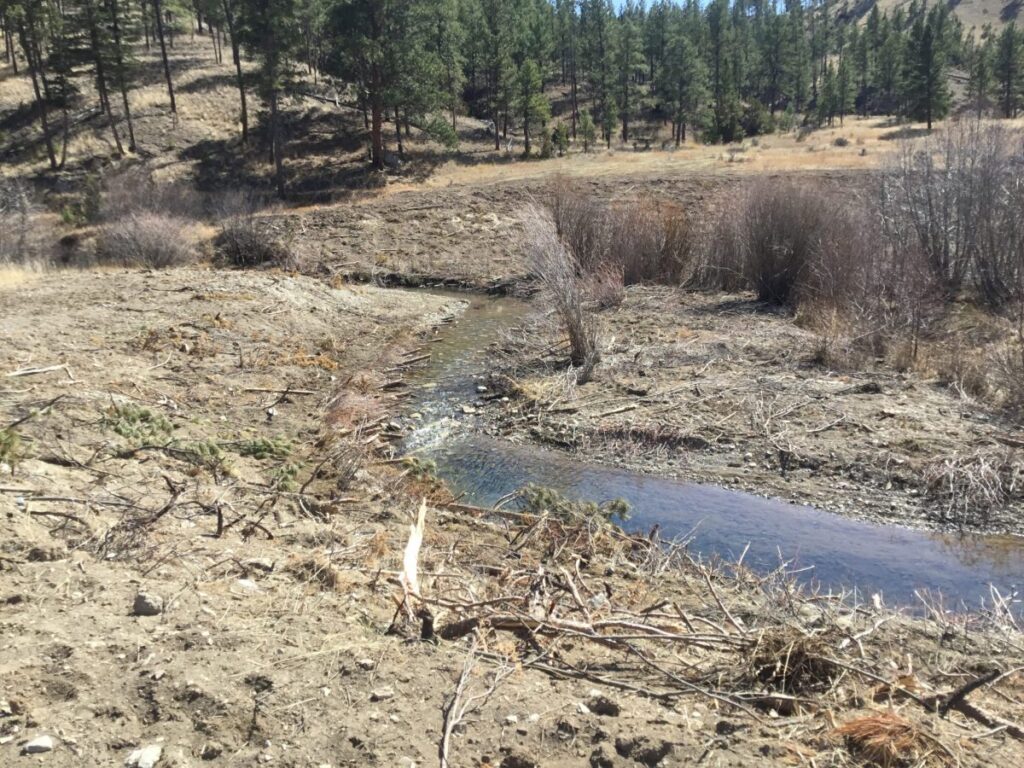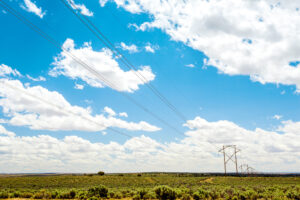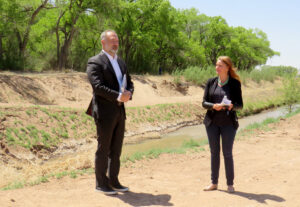Missouri River tributary runs dry after restoration project

Helena anglers are expressing concern over the loss of surface flow in Beaver Creek, an ecologically important tributary of the Missouri River, following restoration work conducted by the U.S. Forest Service late last year.
Buzz Helfert, a 72-year-old East Helena resident, said he spoke with a friend who was unhappy about the stream’s loss of flow, so he visited last month to see for himself. He found about a mile of the stream had gone “bone dry,” a condition he said he’s never seen in his lifetime.
“They disturbed the streambed and dried it up,” he said. “It’s going down a crack in the ground and disappearing.”
The project, which was first proposed by the Forest Service more than two decades ago, was undertaken to restore the stream to a more natural condition after its course had been manipulated for agricultural and other uses dating back to the 1930s. Prior to the Forest Service acquiring the property in 1974, riprap had been added to Beaver Creek’s banks, bends along its length had been straightened, and the stream had lost its connectivity to floodplains, which filter water and create habitat for wildlife, birds in particular.
Project designers River Design Group, based in Whitefish, used remote sensing technology to develop a map of how the stream might have once flowed along the 1.5-mile stretch targeted for restoration. Starting last October, contractors used GPS-guided excavators to raise the streambed, restore oxbows and reconnect the stream to approximately seven acres of historic floodplain. Once the earthmoving wrapped up, the Forest Service started replanting vegetation including willows, alders, chokecherries and cottonwoods to stabilize the banks and improve habitat. Phase one of the project is now complete, and phase two, which involves a similar process on a stretch further downstream, is slated for next year.
A project description submitted by the Forest Service and Trout Unlimited to Montana Fish, Wildlife & Parks for financial support under the agency’s Future Fisheries Improvement Program said the project is expected to improve wild fish populations and angling opportunities.
“Restoring Beaver Creek’s natural stream morphology and hydrologic processes will ‘reset’ the system to provide a dynamic and complex aquatic environment that meets the habitat requirements for all life stages and production of wild trout and other native aquatic species,” the application said.
But anglers like Halfert and Jim Stein, who manages CrossCurrents Fly Shop in Helena, are concerned to find the project appears to have resulted in a loss of surface flow in lower stretches where Beaver Creek joins the Missouri about 12 miles north of Helena.
“None of us were told [the restoration] was going to happen — we weren’t aware of it until [the stream] went underground and suddenly it doesn’t exist anymore for a stretch,” Stein said. “I don’t know if it’s going to pop up again. Some creeks don’t — they go underground forever.”
The Forest Service did publish a decision memo outlining the project and its timeline in June 2019, a year prior to construction.
Alli Russell, a fisheries biologist on the Helena-Lewis and Clark National Forest, said it’s not uncommon for creeks to lose surface flow following the kind of restoration work that’s been conducted on Beaver Creek. She said the work happens to have been done immediately before an “untimely” low water year when both snowpack and spring precipitation were well below normal.
“It’s not that the project didn’t work,” Russell said. “It’s going to take some time.” She said the channel needs time to adjust, refill the aquifer beneath it, and “seal in,” a process by which fine gravels and sediments consolidate along the streambed, helping keep water flowing downstream rather than into the ground.
Helfert is still wary, though.
“That might be the Lewis and Clark Caverns running under that stream — you can’t plan on the stream repairing itself,” he said, adding that the area’s geology makes him particularly concerned.
“If you look at that country, it’s just solid granite batholith boulders. There’s Magpie Creek and Hellgate Creek and a few others and they just fall into the cracks and disappear underground and a while later they might pop up again. But [Beaver Creek] has always been aboveground in my lifetime. … It’s always been a viable stream.”
John Muhfeld, a hydrologist with River Design Group, echoed Russell’s reassurance.
“We’ve seen this on other projects, and in our experience it takes consecutive runoff cycles to recharge alluvial aquifers [and reestablish] perennial flow,” he said.
Muhfeld added that research conducted by Trout Unlimited suggests that the Forest Service’s restoration work will ultimately lead to greater surface flows once the stream has had an opportunity to adjust.
“That work has demonstrated that for every mile of river and floodplain reconnected, we’ve observed up to one cubic foot per second of additional groundwater discharge to the channel during the base flow period, which is a very optimistic trend, and one that we’re certainly hoping to find in Beaver Creek,” he said.
In the meantime, the Forest Service has installed equipment to monitor groundwater levels so it can get a better read on the relationship between Beaver Creek and the shallow aquifer beneath it. Russell said the agency is taking bimonthly measurements. The monitors haven’t been in place long enough to synthesize data and identify trends, she said.
Russell said the agency has fielded enough calls from concerned members of the public that it has installed signs along Beaver Creek with a QR code so smartphone-wielding hikers and anglers can pull up a Forest Service website explaining the restoration project.
TROUT FISHERY IMPACTS UNKNOWN
Beaver Creek is not a large stream — it’s only about 15 miles long, and in some places it’s narrow enough to jump across — but it is an ecologically and economically important one.
Russell said it’s one of the primary spawning tributaries for large migratory trout that come up from Holter Lake — particularly rainbow trout, which spawn in the spring, and brown trout, which spawn in the fall. Fish, Wildlife & Parks stocked Holter Lake with 257,000 rainbow trout in 2020. The Beaver Creek’s brown trout fishery is wild.
According to the Upper Missouri River Reservoir Fisheries Management Plan produced by FWP two years ago, “poor spawning conditions in Beaver Creek will continue to limit wild fish production in the Missouri River.”
Fishing on the 4.6-mile stretch of the Missouri River below Hauser Dam called the Hauser tailwaters accounts for about 31,000 angler days and brings about $7.4 million to the Helena area, Russell said.
During an average year, Beaver Creek maxes out at about 60 cubic feet per second and retains a baseline flow of between 6 and 8 cfs. Russell said it’s not unheard of for parts of Beaver Creek to lose surface flow. During other drought years, notably in the late 1990s and early 2000s, parts of Beaver Creek “did go subsurface,” she said.
What will happen to fish and the insects they feed on if the surface flow ceases for consecutive years remains to be seen.
Both Stein and Helfert expressed worry about what will happen if Beaver Creek trout are prevented from returning to the spawning grounds they were “imprinted with” at the start of their life cycle.
It’s conceivable that FWP could increase stocking efforts once surface flow returns, but Russell said it’s also possible that the department would run up against supply and cost constraints if it pursued that strategy.
Grant Grisak, who manages a fish and wildlife mitigation program on the Missouri River for project partner NorthWestern Energy, said he doesn’t expect to see a negative impact to the fishery.
“Those fish are fairly opportunistic, so if there’s a spawning habitat on Beaver Creek, they’ll use it, [but] if there’s not they’ll likely use something else. From a population management standpoint, the more opportunities you have, the better — that’s the whole reason Beaver Creek was selected [for restoration] almost 30 years ago.”
“We believe the future’s bright for Beaver Creek — it’s just kind of caught during a very low water year, the first year after construction,” he continued.
NorthWestern Energy is one of the project’s main funders. The utility company’s federal license to operate eight hydroelectric dams along the Missouri and Madison rivers requires it to participate in efforts to mitigate the dams’ impacts to fisheries and wildlife habitat. The Beaver Creek restoration is one of those mitigation projects. The company has contributed $85,000 to fund the restoration design and $350,000 for construction, according to Andy Welch, who manages NorthWestern’s hydro license and compliance group.
In addition to financial support, the Pat Barnes Missouri River Chapter of Trout Unlimited has contributed volunteer hours to the project.
PHASE TWO PLANNED FOR 2022
Phase two of the project, which involves a similar strategy involving a 0.7-mile stretch of Beaver Creek closer to its confluence with the Missouri, is slated to start in fall 2022.
Russell said the Forest Service initially intended to start phase two this year, but “resource considerations” caused the agency and its partners to push back the start date.
Muhfeld said the streambed elevation gradient — which dictates the amount of earth moving that’s necessary — is less dramatic on that lower stretch.
“The risk of channel dewatering in phase two should be less,” he said.
Phase two is expected to cost just shy of $500,000.
This article was originally posted on Missouri River tributary runs dry after restoration project







